DRIVEN: 2016 Mini Cooper convertible
A week with the Mini Convertible revealed that 'Mini fun' is not reserved only for S models, writes Ntsako Mthethwa.
The 2016 Mini Cooper convertible isn’t an all-new car from the folks that gave us the first Mini model launched by BMW under the Mini marque after the original car was discontinued in 2000; with all the fun and driving dynamics, it has proven impressive handling.
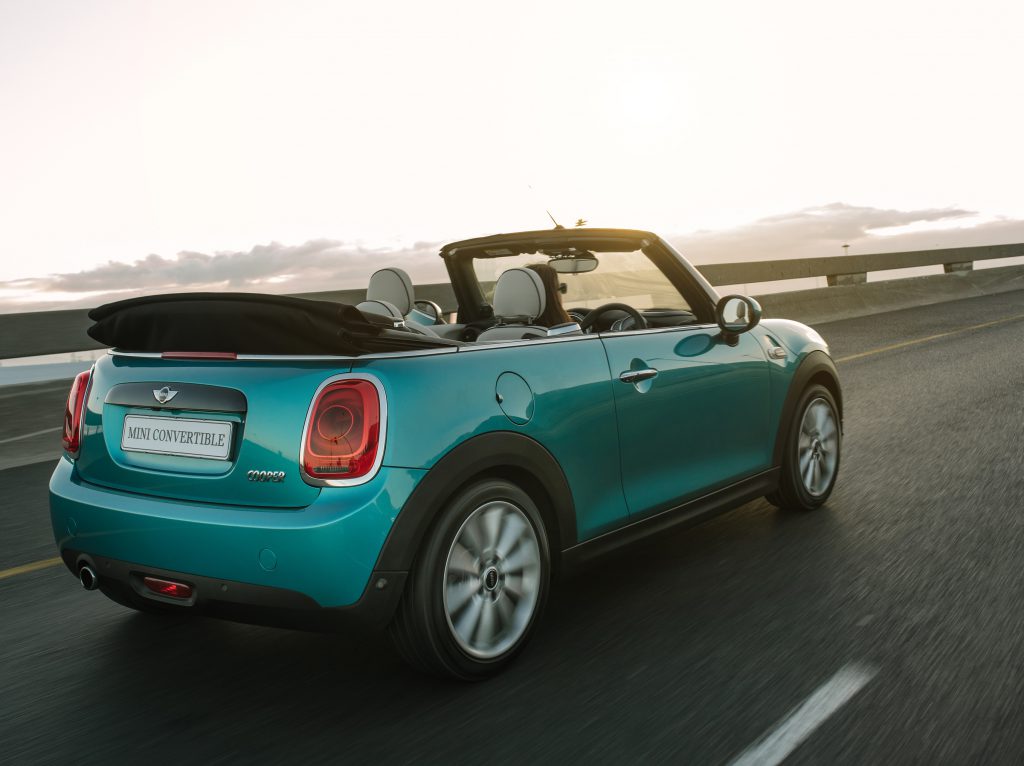
.
The Mini convertible gives one a reason to feel excited. Over the years, the car maker has proven itself in making very fun and easy to drive cars and, without a doubt, has ambitions to do so again.
Although the Mini convertible didn’t do well in terms of sales, it remains the headline of the German marque for taking on the likes of the Fiat 500C.
Now joining the hatchback in its third generation, it isn’t so ‘mini’ at all. Increased dimensions mean it’s more spacious inside too. The roof has been improved and the boot has been made bigger.
Despite its iconic and still relatively small size, Mini has done a very good job of transferring all the fun, handling and driving dynamics of the hardtop to the Convertible – to give you that open-top driving feeling, just in time for the summer heat.
Step inside the car, and the Mini has never been made better. Fit and finish are excellent and the car is comfortable and quiet even with the roof down, particularly if you’re sitting up front.
As much fun and easy to drive as the Mini is, it remains expensive to buy; it is still one of the best convertibles on the market today. If you’re after a fun and small car that delivers wind-in-your hair thrills when the weather is good, there isn’t much out there that can beat this convertible.
Like its hatchback counterpart, it drives fairly well even with the roof down considering that removing the roof of a car traditionally has a negative effect on handling; this one has proven us wrong. Just like the hatchback we drove during its launch in Cape Town early this year, the convertible generates plenty of grip as well as feeling agile and adjustable through the corners.
As with the other Minis, you get three driving modes you can choose from, Green, Mid and Sport. By default, the car is in Mid mode, which means it will be balanced between the SPORT and GREEN modes, offering a combination of both of them. Sport mode makes the car more fun to drive as it sharpens up the throttle and makes the steering more involving by decreasing the amount of assistance. Going the other way around, into GREEN mode, you’ll notice the other side of the Mini, the one that saves fuel for the sake of the planet.
In the much-tamed JCW and Cooper S, the ‘burps’ are more audible and more entertaining when the Sport mode is engaged.
Is it safe?
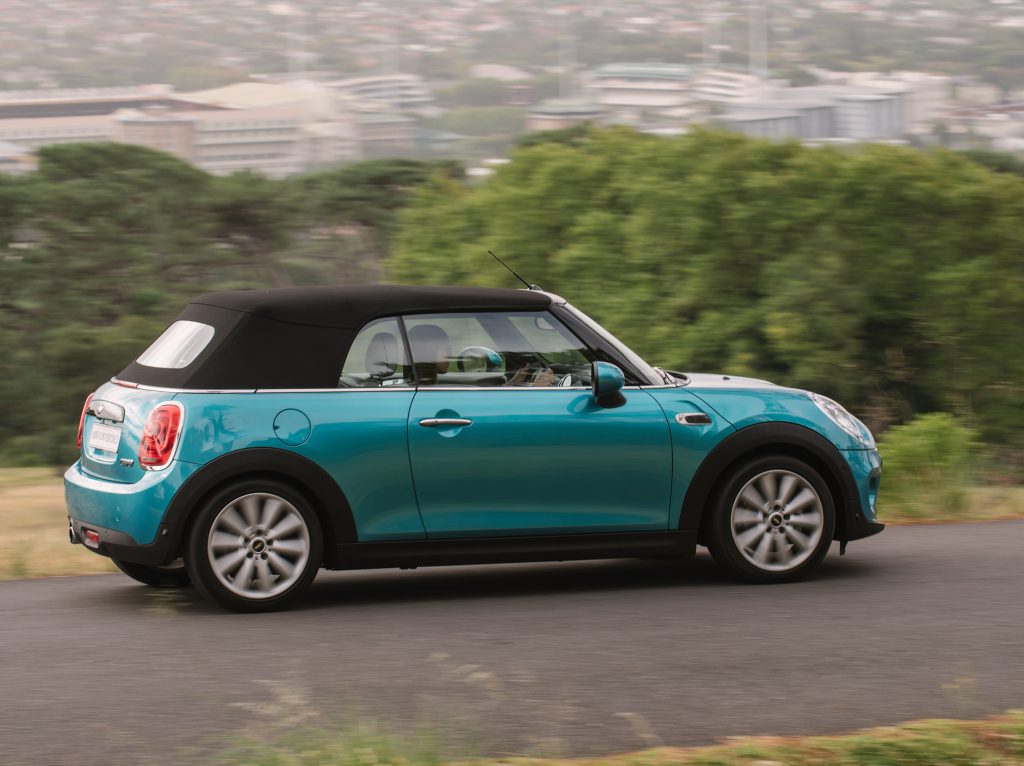
.
The Mini hatchback scored four out of five stars when it was crash-tested by Euro NCAP in 2014 and we’d expect the convertible version to prove just as safe.
Mini has safety in mind, rest assured, when designing the car. It has a high-quality textile soft top with fully automatic opening and closing mechanism as well as sliding roof function.
Opening and closing of the soft top and side windows happens in 18 seconds, which is also possible during travel at speeds of up to 30 km/h; invisibly integrated rollover protection extends automatically when required as a convertible-specific component of the integrated MINI safety concept.
Highly rigid body structure with model-specific bracing elements really provide an agile driving response with maximum occupant protection. Our test unit was equipped with a complete set of standard safety features which included front airbags, head-thorax airbags, which are integrated in the backrests, and a 3-point automatic belts on all seats.
Should you wish to have a baby car seat, the Mini comes standard with ISOFIX child seat mountings for the passenger seat and at the rear. There’s three pressure display and a partially active engine compartment lid for optimum pedestrian protection; needs-based control of the restraint systems and rollover protection by means of centralised safety electronics.
Spacious?
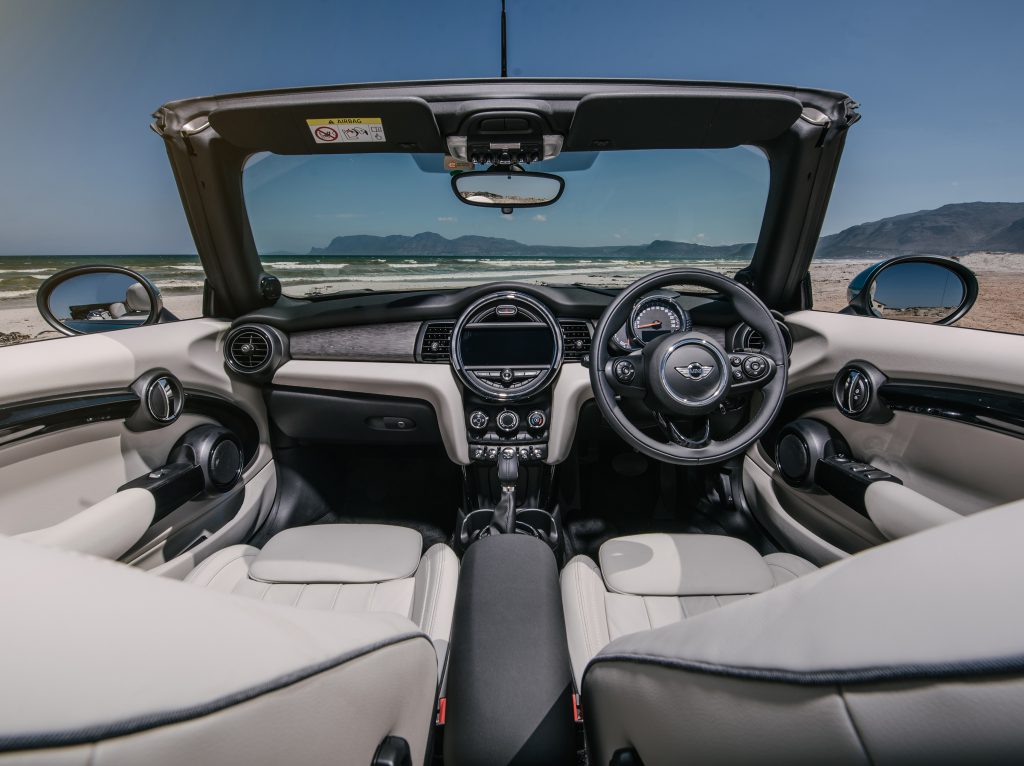
.
In terms of space, the new convertible’s length gives backseat occupants an extra 1.6 inches of legroom and half an inch more shoulder room. However, a 1.5m friend of mine seated at the back constantly complained about the seating position and we had to slide the front seats a little forward to accommodate him.
The car’s increased dimensions haven’t made just the cabin more spacious: there’s also 25% more room in the boot.
We still had to scoot the passenger seat pretty far forward to accommodate our legs comfortably, and with our shoulders brushing against the sides of the car, we wouldn’t want to ride in the back for longer than it takes to, say, run to get ice cream with friends.
There are also child-seat anchors, which seems like the most useful application for the back seats.
Although Mini claims that the luggage compartment increases when the soft top is closed by means of the Easy Load function which comes as standard, boot space remains a challenge.
Two locking handles enable the soft top frame to be swung higher up than in the predecessor model so as to facilitate stowage of large-format luggage items.
The luggage compartment volume of the new Mini Convertible is 160 litres with the soft top open and 215 litres when it is closed.
Many owners will be even more inclined to use the rear seats as extra luggage space which, incidentally, splits and fold down.
When the roof is up, the main boot lid folds down as normal, and you can then lift the rear deck to get larger items in and out a bit easier.
How does it drive?
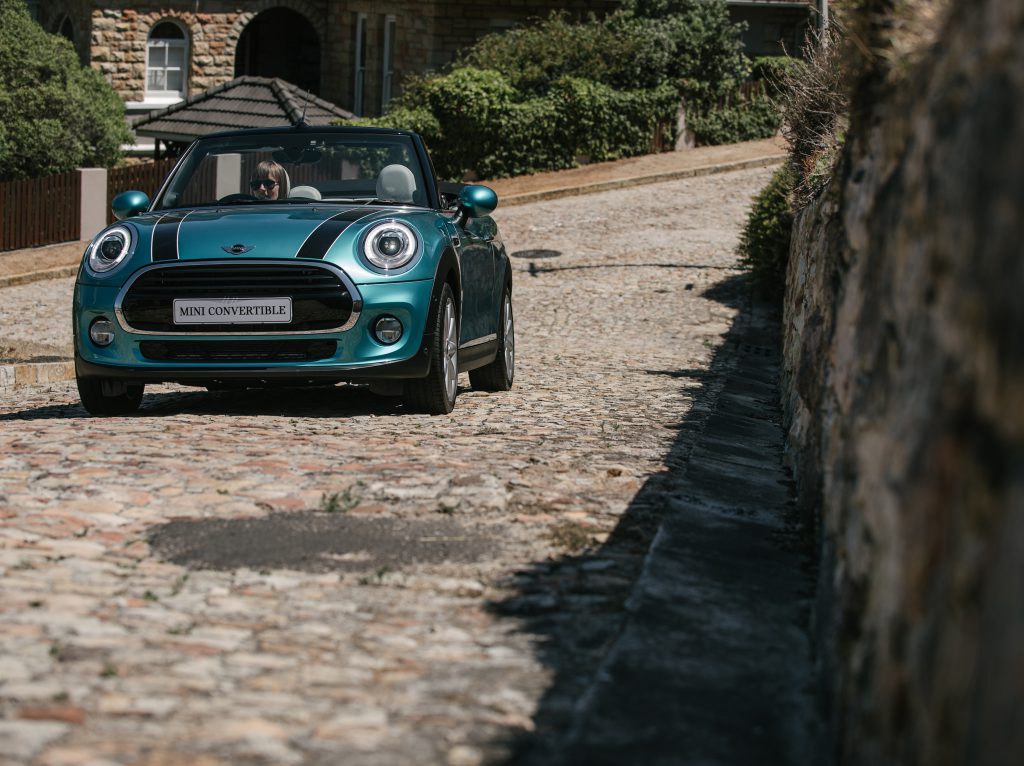
.
A quick spin in this base Cooper, with its 100kW and 220Nm of torque, turbo three-cylinder mated to a six-speed automatic transmission, reveals that Mini fun is not reserved only for S models.
On poorly maintained roads, the Mini Convertible’s suspension soaks up big pothole impacts far more ably than its predecessors.
Convertibles with fabric roofs can be noisy, particularly at speed, but wind roar isn’t at all bad in the Mini Convertible. Driving on the motorway doesn’t create too much buffeting for occupants in the front, but those in the back might find life rather windswept and everyone would benefit from a wind deflector.
Quivers ripple through the chassis over big impacts despite the new car’s extra bracing, but the overall impression is one of far greater ride comfort than in any prior topless Mini.
Sport mode stiffens the optional adaptive dampers, but the convertible rides with a sense of compliance rather than punishment.
Quick steering and a suspension that resists body roll work together to make the Mini a playful backroad companion.
With a narrow track and short wheelbase, plus the fact the driver sits so close to the front wheels, the Mini seems to change direction instantly.
The electric power steering is still a little too vague for our liking, but its delicate feel pays dividends when making tight manoeuvres in the city.
Though there’s a lot less power on tap, the Cooper’s eager, responsive engine still zips, and even on its smaller, less sporty tyres, the car hangs on enthusiastically around traffic circles.
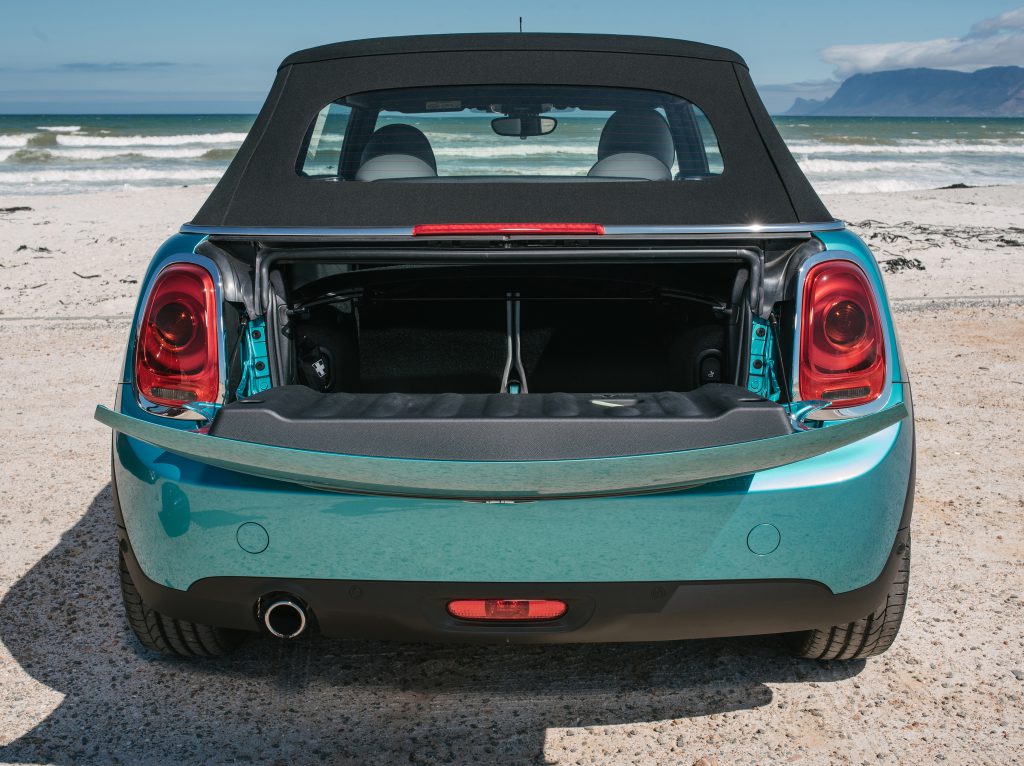
.
Pros
- Fun to drive
- High-quality interior
- Cheap to run.
- Driving position is spot-on.
- 18s/ 30km/h of closing and opening the roof becomes more useful in traffic congested situations.
Cons
- Expensive options
- Windy for rear passengers
- Not enough boot space.
- Rear space and seating position not good for taller people.
- Good for singles and as a daily commute.
Our word
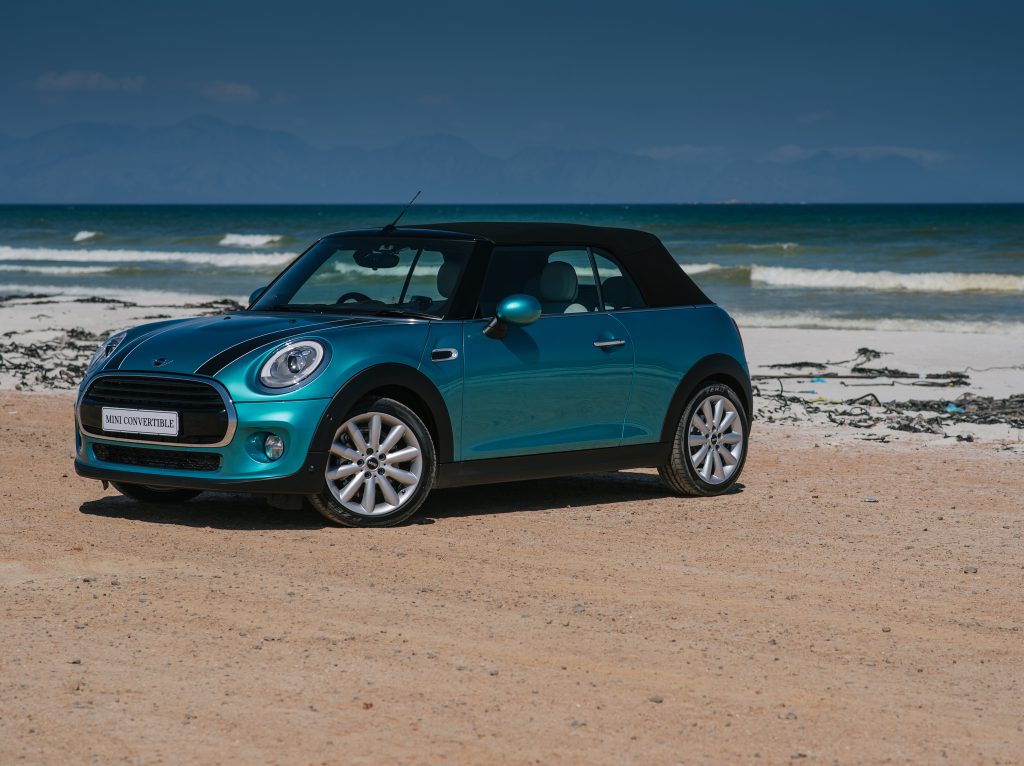
.
Mini has an impressive image and is very desirable among the car-buying public and, while this makes for good residual values, it also means there are cheaper alternatives that you can look for.
If space tops the list of things you are looking for in a car; sadly, the Mini doesn’t deliver it in spades.
However, neither of the Mini’s rivals is as fun to drive as this, so it’s up to you to decide whether it’s worth it.
Specifications
Engine: 3-cylinder petrol engine with MINI TwinPower Turbo Technology (turbo charging, direct injection, fully variable valve control, variable camshaft control), capacity: 1 499 cc.
Power: 100 kW at 4 400 rpm, max. torque: 220 Nm at 1 250 rpm (230 Nm with overboost).
Acceleration: (0–100 km/h): 8.8 seconds (automatic: 8.7 seconds), top speed: 208 km/h (206 km/h), average fuel consumption*: 5.1 – 4.9 litres (5.3 – 5.1 litres)/100 kilometres,
CO2 emissions*: 118 – 114 g/km (123 – 119 g/km), exhaust emission standard: EU6.
Price: R368 000 (Manual) and R384 000 (Automatic)
* EU test cycle figures, fuel consumption dependent on the selected tyre format.
Thanks to Mini SA for the car. For more information and to book for a test drive, visit https://www.mini.co.za/en_ZA/home.html







